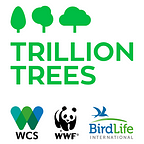Climate action needs more than just tree planting
With new forest finance pledged just two months ago at COP26 in Glasgow, now is the time to seize the moment to direct those funds to deliver genuine impact. The Trillion Trees partnership for forests has developed a first-of-its-kind interactive tool to help investors make their funding choices, as our Executive Director John Lotspeich explains.
In the immediate aftermath of Glasgow, I wrote of my optimism that a combined US$20 billion of public and private finance had been committed to place the world’s forests at the centre of the fight against the triple threats assailing our planet — climate change, nature degradation and social injustice. We have only nine years to deliver on its promises. We don’t have time for more words. It’s time to turn pledges into action.
But action alone won’t save us. It needs to be the right sort of action. With the time pressures we’re facing, we need to get the most out of every intervention and out of every dollar spent on climate action, and particularly on Nature-based Solutions. Across our partnership at Trillion Trees, we see many excellent programmes taking shape to protect and restore forests across the globe — and others less likely to deliver what is needed.
That’s why the time is right to launch our practical guide to investing in forest restoration.
This brand new interactive online tool is not only the first of its kind — it aims to assess the benefits of restoration projects to people, nature and the climate — it is also straightforward to use and provides an automatic score.
Through a series of nine foundational questions, it equips potential investors — private and institutional — to interrogate any forest restoration project that crosses their desk, so they can be confident they are directing their money where the funds have a greater chance of delivering results. The tool scores the candidate project against these nine key tests, emerging with an overall tally as a guide to decision-making. Along the way, users will learn exactly what to ask — and why — when interrogating a forest programme (or programme implementer) and can tap into additional information which unpacks the thinking behind each question. The aim is for the user to emerge with a deeper understanding of what makes a restoration project most likely to deliver on its objectives, and how to measure its impact.
The tool interrogates programmes against the core principles developed by the Trillion Trees partners. In building the tool, we have worked in collaboration with the Nature4Climate initiative, following the principles set out in the UN Decade on Ecosystem Restoration and other global guidance [[1]] and have drawn on the deep experience of the Trillion Trees partners over decades of front-line conservation work.
In brief, the tool aims to put into an investment context the argument that the best way to deliver progress against the ‘triple challenge’ of a climate crisis, a global crash in biodiversity and increasing inequality of opportunity for people, is not to just plant trees at random, but do so within a framework that protects what we already have, works to end the causes of deforestation and restores forests in the best way science tells us.
And in a world where market forces drive so much decision making, the tool also underscores the too-often ignored rights and livelihoods of the indigenous peoples and local forest communities who are the ideal stewards of forest conservation work.
Finally, and perhaps most challengingly, the tool queries any project’s commitment to and ability to deliver, measure and evaluate progress against its promised objectives. This could mean recording tree survival rates or forest expansion, carrying out surveys to see whether wildlife populations have grown or tracking the well-being of the people delivering the project, for example. Only with verified and transparent outcomes can we know what works, what needs adapting, and what can be scaled up to meet the urgent need for forest restoration worldwide.
The scores aren’t indicative of the quality or excellence of a project itself, more a tally of the likelihood that a project can for example — if so designed — deliver more for the planet than just carbon capture. Here’s a flavour of what I mean: An excellent tree-planting scheme designed to deliver income and cooking fuel can score well on the question of human benefit but may not have considered wildlife habitat (of pollinating bees, for example), or even calculated whether there could be a climate benefit (soil stability, water purification or carbon capture). Each total score will indicate whether or not the project delivers for climate, for nature and for people.
Why not have a go and see how an initiative you are considering scores? The tool can be found here on the Trillion Trees website.
We’re extremely grateful to all the incredible technical support we’ve had to bring this innovative, evidenced-based tool to the global forest community post-COP26. We hope that it will help potential funders, whoever they may be, to understand how much good can be done with smart investments in forest landscapes, because as I’ve said before… we don’t have time to spare.
[1] The tool follows the principles of IUCN’s Forest Landscape Restoration guidance, the UN Decade on Ecosystem Restoration and Kew Garden’s Ten Golden Rules for restoring forests.
